
drawing, pencil
#
portrait
#
drawing
#
impressionism
#
pencil sketch
#
figuration
#
pencil
#
realism
Dimensions: height 346 mm, width 250 mm
Copyright: Rijks Museum: Open Domain
Curator: I find myself drawn to the quiet intensity in this drawing; Pieter de Josselin de Jong captures something so introspective in "Kerkgang," rendered in pencil sometime between 1871 and 1906. Editor: The first thing that strikes me is the young woman's posture – head bowed, hands clasped. There’s an undeniable sense of vulnerability and perhaps even constraint in how she holds herself. It reminds me of portraits depicting women of that era; we only ever get hints of their internal lives. Curator: It’s precisely that dance between what’s revealed and what’s withheld that I find so captivating. Look at the fluidity of the lines. The artist’s able to capture a fleeting moment with such elegant economy! It's more feeling than strict representation. Editor: True, the impressionistic style adds a certain ambiguity. The sketch is suggestive, hinting at stories, but tell me – do you think the "Kerkgang" of the title directly implies that this is simply about attending church, or is there potentially some other, more social dimension? Perhaps it is also commenting on what happens outside a church. Curator: That’s where it becomes juicy, doesn't it? Is it a moment of prayer, societal pressure, quiet rebellion? The question resonates. What do you read into her clothing? Editor: Her clothes speak volumes – that hat, that layered dress, even the hint of the patterned underskirt. They indicate her status, yes, but perhaps they are constraints imposed upon her too. Church then was an incredibly policed space for women and their expression. We only have her bowed head as our own resistance. Curator: I think that's what resonates about this sketch - it becomes more universal as the years pass, even though the fashions are a product of a bygone era. Editor: Exactly, and this artist leaves space for us to project ourselves. Curator: Indeed. Looking at this image leaves me contemplative about our social rituals. Editor: Absolutely; a drawing like this invites us to confront our own presumptions about the narratives embedded within depictions of women from this period. It challenges the notion of visibility, really – who gets seen, and how.
Comments
No comments
Be the first to comment and join the conversation on the ultimate creative platform.













